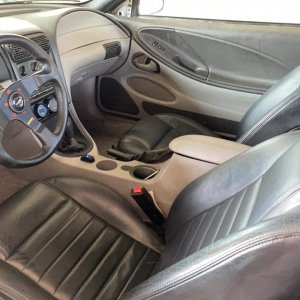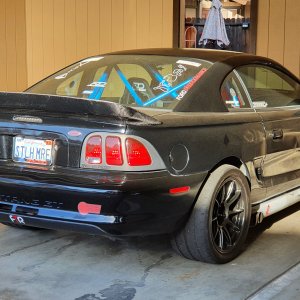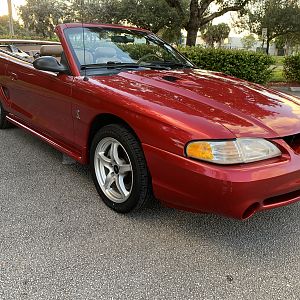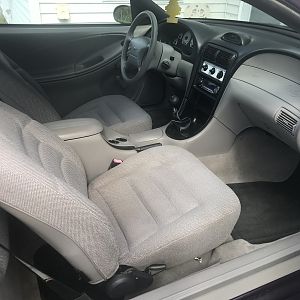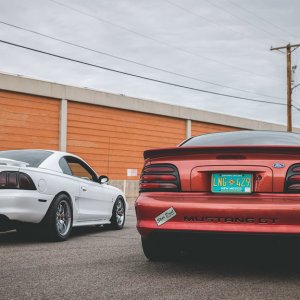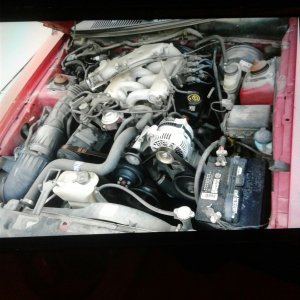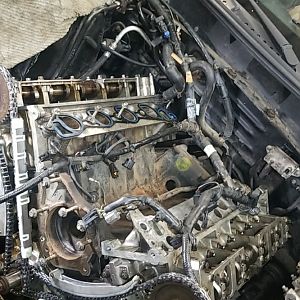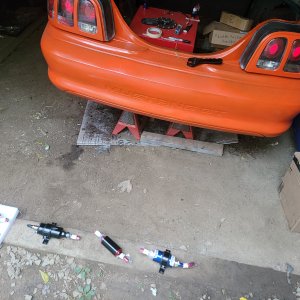Ah, so you THINK you're an expert... you THINK you're the mighty all-knowing bad ass of bad assness.... every forum has one. In our case, maybe it's YOU.
But before you start spreading mis-information and filling our forum with garbage (that’s my job, and I don’t like competition.) I figure I'd set you straight before we all laugh at you...
Maybe you are just looking for the best 4v heads to get for your "build." And you want used, because those new FRPP 2000 Cobra R heads are outragiously expensive!
So, here’s a run-down on some Ford, modular, 4v tech. Let's find which year/make/model head is best for you! :-D
First, as well remember from high-school public speaking class, the first thing you do is define yourself as an authoritative figure.
I, MustangChris, have swapped a 2004 cobra motor into my 1996 Mustang GT. This was a two year long process that i performed 90% of the work on (minus anything requiring a welder or plasma cutter.) This project took place in my garage with basic hand tools before heading to my uncle's shop for major frame and chassis work. At no point was my car worked on by a "professional" shop, and at no point did anything get worked on without me being present. The only work being performed by a shop on my car is the dyno tune and a custom exhaust. My car runs on E85 and Pump gas (dual tune) and has an estimated 500RWHP.
There is a "members ride" thread with pictures of my car.
There is a "build thread" with the step-by-step process of my car's history.
There is a YouTube video (also in my build thread) of my car running.
Why should I trust you, Chris?
Well, my build began with the famous teksid block as the power plant. I began to purchase parts (4v C-heads off a terminator, just one example) before I realized that I was in too deep. I was clicking "buy it now" on eBay like it was going out of style. I had to take a step backwards, get my composure, learn what the **** I was doing, and build a car within a short period of time. Now, you get the benefit of my hard work and dedication in one lovely thread. :-D
Basics:
2v, 3v, 4v.
The 2v is known as the SOHC (single overhead cam) engine. I won’t be talking about it here because there are far smarter folk on the forum who can give you better tech than I can on the mighty 2v.
The 3v is known as "the 3v†(oh. makes sense...) I won’t be talking about it here because this is the 4v section of the forum, and I don’t want to get into VVT/VCT.
The 4v is where the meat is. It's what people spend thousands of dollars to put into their mustangs. Let's get started!
Ford Modular engines (modular meaning "a self-contained unit that can be combined or interchanged with others like it to create different shapes or designs." -http://dictionary.reference.com/browse/modular) have been present since 1991 (Lincoln Town Cars - http://en.wikipedia.org/wiki/Lincoln_Town_Car). Other modular engines include: 4.6L, 5.0L Coyote, 5.4L, 5.8L, 6.8L V10 and a series of motors sent to Australia that I know nothing about...
It took until 1993 for Ford to design and produce a 4v cylinder head for this modular engine. And this first 4v cylinder head was placed on the 1993 Lincoln Mark VIII. These same heads were used on the 1996-1998 Mustang Cobras. These heads are known as "B-heads" and they have a list of benefits, and a list of draw backs.
Let’s take a look at the basic design:
These heads are known as "split port, dual port, or swirl port." This means that there are two intake ports for each cylinder. The square primary port and round secondary port make up the design.
Benefits:
Flow, Flow, Flow.
--These heads flow quite well, especially at higher RPMs. These heads flow well even up to 8,000 RPMs (mind you valve train needs a different set-up.) (http://www.modmotortech.com/forums/archive/index.php/t-295.html)
This large amount of flow brings down the head's lower and mid-range intake port velocity and as a result lower and mid-range torque was lost. Ford included intake manifold runner controls (IMRCs). These are computer actuated butter-fly flaps that open at certain RPMs. By closing the secondary port at lower RPMs, velocity and torque are somewhat returned. By opening this port (3250RPMs) the engine is supplied ample airflow for the higher demand.
We can see a picture of these IMRCs here:
http://mdmustangs.com/David_Simmons_Cobra/imrc.html
Due to Ford no longer offering parts or service for IMRCs systems, many people opt to simple delete these. This allows the port to stay open at all times.
(Kits are available everywhere, http://www.modularmustangracing.com/prod_dohc.htm for example.)
A drawback to this design is many feel the intake manifolds provided with these heads cannot supply ample air to the heads. These heads flow extremely well, yet the manifold is starving them. The lack of aftermarket intake manifolds pushed this head into the "caveman era" as newer technology was released by ford.
(There are now intake manifolds available for this head design: http://www.modularmustangracing.com/prod_dohc.htm as the popularity for race-only applications for these heads increases)
Another drawback to these heads is the air/fuel ratio blend when the combination enters the combustion chamber. Some fear that while there are two intake ports, and only one injector, the system is lacking enough fuel delivery. *OR* if there is enough fuel delivery, it is not mixed properly for maximum burn-off. I have found very little information (readily available) to back this claim up.
A perk to these heads is the fact that most dismiss them as junk. Nothing more than door-stops to the shop. The lack of IMRC support from ford, the lack of aftermarket manifolds, and the newer designs from ford have made these heads easily accessible and cheap to get. They function quite well at higher RPMs and they respond to forced induction applications better than most suspect.
If you've heard of accufab, you've heard of making 2,000 Horsepower on a teksid block. BUT you may not know that their choice of heads was a set of "b-heads."
"The "Stock" Combination. What makes John's power and speed so impressive is the small displacement and stock source for major portions of his engine program. Displacement is 282 ci--call it a stock 4.6 liters--using a stock aluminum Cobra block; stock old-style, 'B' dual-port, Four-Valve cylinder heads, as found in a '95 Lincoln; and a stock 4.6 Cobra crankshaft."
-http://www.accufabracing.com/index.php/racing.html
These heads are running at 52 Pounds of Boost creating 2,300 horsepower!! Not bad for something most people dismiss as garbage.
Not to mention the b-head-equipped engines made Ward's best 10 engines for 1996 and 1997.
http://en.wikipedia.org/wiki/Ward's_10_Best_Engines
Out with the old, in with the new!
Tumble Port head design:
The tumble port head design was brought in in 1999 for the mustang cobra. It was duplicated in 2001 for the cobra, as well. These cobras were naturally aspirated and required the tumble port design to feed two intake valves with one port. They were equipped with new cams and fixed runner length intake manifolds. These heads gave a "broader" power band than the earlier designed B-heads.
The tumble port design gives a more-efficient air/fuel mixture than the B head designed did, but they have a short turn radius in the throat of the intake port.
This short turn radius forces the incoming air to improperly enter the combustion chamber when passing through the valve. Due to the flawed design, cooling of the intake valves on #6, 7, and 8 cylinders was compensated and they were known to over-heat and seat improperly.
(http://www.modmotortech.com/forums/archive/index.php/t-295.html)
But before you start spreading mis-information and filling our forum with garbage (that’s my job, and I don’t like competition.) I figure I'd set you straight before we all laugh at you...
Maybe you are just looking for the best 4v heads to get for your "build." And you want used, because those new FRPP 2000 Cobra R heads are outragiously expensive!
So, here’s a run-down on some Ford, modular, 4v tech. Let's find which year/make/model head is best for you! :-D
First, as well remember from high-school public speaking class, the first thing you do is define yourself as an authoritative figure.
I, MustangChris, have swapped a 2004 cobra motor into my 1996 Mustang GT. This was a two year long process that i performed 90% of the work on (minus anything requiring a welder or plasma cutter.) This project took place in my garage with basic hand tools before heading to my uncle's shop for major frame and chassis work. At no point was my car worked on by a "professional" shop, and at no point did anything get worked on without me being present. The only work being performed by a shop on my car is the dyno tune and a custom exhaust. My car runs on E85 and Pump gas (dual tune) and has an estimated 500RWHP.
There is a "members ride" thread with pictures of my car.
There is a "build thread" with the step-by-step process of my car's history.
There is a YouTube video (also in my build thread) of my car running.
Why should I trust you, Chris?
Well, my build began with the famous teksid block as the power plant. I began to purchase parts (4v C-heads off a terminator, just one example) before I realized that I was in too deep. I was clicking "buy it now" on eBay like it was going out of style. I had to take a step backwards, get my composure, learn what the **** I was doing, and build a car within a short period of time. Now, you get the benefit of my hard work and dedication in one lovely thread. :-D
Basics:
2v, 3v, 4v.
The 2v is known as the SOHC (single overhead cam) engine. I won’t be talking about it here because there are far smarter folk on the forum who can give you better tech than I can on the mighty 2v.
The 3v is known as "the 3v†(oh. makes sense...) I won’t be talking about it here because this is the 4v section of the forum, and I don’t want to get into VVT/VCT.
The 4v is where the meat is. It's what people spend thousands of dollars to put into their mustangs. Let's get started!
Ford Modular engines (modular meaning "a self-contained unit that can be combined or interchanged with others like it to create different shapes or designs." -http://dictionary.reference.com/browse/modular) have been present since 1991 (Lincoln Town Cars - http://en.wikipedia.org/wiki/Lincoln_Town_Car). Other modular engines include: 4.6L, 5.0L Coyote, 5.4L, 5.8L, 6.8L V10 and a series of motors sent to Australia that I know nothing about...
It took until 1993 for Ford to design and produce a 4v cylinder head for this modular engine. And this first 4v cylinder head was placed on the 1993 Lincoln Mark VIII. These same heads were used on the 1996-1998 Mustang Cobras. These heads are known as "B-heads" and they have a list of benefits, and a list of draw backs.
Let’s take a look at the basic design:
These heads are known as "split port, dual port, or swirl port." This means that there are two intake ports for each cylinder. The square primary port and round secondary port make up the design.
Benefits:
Flow, Flow, Flow.
--These heads flow quite well, especially at higher RPMs. These heads flow well even up to 8,000 RPMs (mind you valve train needs a different set-up.) (http://www.modmotortech.com/forums/archive/index.php/t-295.html)
This large amount of flow brings down the head's lower and mid-range intake port velocity and as a result lower and mid-range torque was lost. Ford included intake manifold runner controls (IMRCs). These are computer actuated butter-fly flaps that open at certain RPMs. By closing the secondary port at lower RPMs, velocity and torque are somewhat returned. By opening this port (3250RPMs) the engine is supplied ample airflow for the higher demand.
We can see a picture of these IMRCs here:
http://mdmustangs.com/David_Simmons_Cobra/imrc.html
Due to Ford no longer offering parts or service for IMRCs systems, many people opt to simple delete these. This allows the port to stay open at all times.
(Kits are available everywhere, http://www.modularmustangracing.com/prod_dohc.htm for example.)
A drawback to this design is many feel the intake manifolds provided with these heads cannot supply ample air to the heads. These heads flow extremely well, yet the manifold is starving them. The lack of aftermarket intake manifolds pushed this head into the "caveman era" as newer technology was released by ford.
(There are now intake manifolds available for this head design: http://www.modularmustangracing.com/prod_dohc.htm as the popularity for race-only applications for these heads increases)
Another drawback to these heads is the air/fuel ratio blend when the combination enters the combustion chamber. Some fear that while there are two intake ports, and only one injector, the system is lacking enough fuel delivery. *OR* if there is enough fuel delivery, it is not mixed properly for maximum burn-off. I have found very little information (readily available) to back this claim up.
A perk to these heads is the fact that most dismiss them as junk. Nothing more than door-stops to the shop. The lack of IMRC support from ford, the lack of aftermarket manifolds, and the newer designs from ford have made these heads easily accessible and cheap to get. They function quite well at higher RPMs and they respond to forced induction applications better than most suspect.
If you've heard of accufab, you've heard of making 2,000 Horsepower on a teksid block. BUT you may not know that their choice of heads was a set of "b-heads."
"The "Stock" Combination. What makes John's power and speed so impressive is the small displacement and stock source for major portions of his engine program. Displacement is 282 ci--call it a stock 4.6 liters--using a stock aluminum Cobra block; stock old-style, 'B' dual-port, Four-Valve cylinder heads, as found in a '95 Lincoln; and a stock 4.6 Cobra crankshaft."
-http://www.accufabracing.com/index.php/racing.html
These heads are running at 52 Pounds of Boost creating 2,300 horsepower!! Not bad for something most people dismiss as garbage.
Not to mention the b-head-equipped engines made Ward's best 10 engines for 1996 and 1997.
http://en.wikipedia.org/wiki/Ward's_10_Best_Engines
Out with the old, in with the new!
Tumble Port head design:
The tumble port head design was brought in in 1999 for the mustang cobra. It was duplicated in 2001 for the cobra, as well. These cobras were naturally aspirated and required the tumble port design to feed two intake valves with one port. They were equipped with new cams and fixed runner length intake manifolds. These heads gave a "broader" power band than the earlier designed B-heads.
The tumble port design gives a more-efficient air/fuel mixture than the B head designed did, but they have a short turn radius in the throat of the intake port.
This short turn radius forces the incoming air to improperly enter the combustion chamber when passing through the valve. Due to the flawed design, cooling of the intake valves on #6, 7, and 8 cylinders was compensated and they were known to over-heat and seat improperly.
(http://www.modmotortech.com/forums/archive/index.php/t-295.html)


